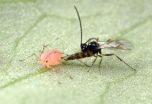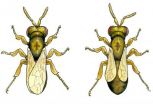(Press-News.org) In the war between parasite and host, the parasitic wasp, Aphidius ervi, and the pea aphid, Acyrthosiphon pisum, are locked in a battle for survival. New research published in BioMed Central's open access journal BMC Biology shows that this cunning parasite sniffs out differences between protected and unprotected aphids, and alters its egg-laying strategy, in order to overwhelm aphid defenses and ensure survival of wasp offspring.
The wasp, A. ervi, lays an egg inside the pea aphid, where the egg hatches and converts the aphid's insides into a wasp nursery. The wasp larva uses the still-living aphid as a food source, eventually pupating inside the aphid and emerging as a fully-formed mature wasp. However the pea aphid is not defenseless. It is protected by a bacterial symbiont Hamiltonella defensa (and its associated bacteriophage APSE).
Although the wasps still lay their eggs, wasp larvae are unable to develop normally. Researchers from the Universities of Georgia and Arizona collaborated with researchers from Akita Prefectural University, Japan, to investigate what tactics the wasps might use to overcome the aphids' symbiont defense strategy. The researchers found that wasps which laid two eggs (superparasitism) in aphids infected with H. defensa and APSE were much more successful at producing live offspring.
However laying two eggs in uninfected hosts had little effect on the number of surviving wasps as only one wasp can complete development in each aphid. This suggests that having twice the amount of factors secreted by the developing wasp overpowers the protection due to bacterial infection, and is an adaption to ensure the survival of one wasp at the cost of two.
In a twist it seems that the wasps are able to work out which aphids are harboring the symbionts and which are not. Dr Kerry Oliver, who led this study, explained, "We discovered that A. ervi would preferentially lay two eggs in infected hosts, and a single egg if the aphids were unprotected. We don't for sure how wasps discriminate, but, when we looked for differences between the aphids, we found that infected aphids produced less of the compound trans-b-farnesene. This compound is a major component of aphid alarm pheromone and wasps are known to use this cue to find hosts."
Whatever the trick that they are using to work out which aphids are infected, wasps appear to be able to lay just enough eggs to stay ahead in the arms race.
INFORMATION:
Notes to Editors
1. Parasitic wasp responses to symbiont-based defense in aphids
Kerry M Oliver, Koji Noge, Emma M Huang, Jamie M Campos, Judith X Becerra and Martha S Hunter
BMC Biology (in press)
Please name the journal in any story you write. If you are writing for the web, please link to the article. All articles are available free of charge, according to BioMed Central's open access policy.
Article citation and URL available on request at press@biomedcentral.com on the day of publication.
2. BMC Biology is the flagship biology journal of the BMC series, publishing open-access, peer-reviewed research and methodology articles of special importance and broad interest in any area of biology, as well as reviews, opinion pieces, comment and Q&As on topics of special or topical interest.
3. BioMed Central (http://www.biomedcentral.com/) is an STM (Science, Technology and Medicine) publisher which has pioneered the open access publishing model. All peer-reviewed research articles published by BioMed Central are made immediately and freely accessible online, and are licensed to allow redistribution and reuse. BioMed Central is part of Springer Science+Business Media, a leading global publisher in the STM sector.
Cunning super-parasitic wasps sniff out protected aphids and overwhelm their defenses
2012-02-24
ELSE PRESS RELEASES FROM THIS DATE:
Pardee Homes' Crest View at Fair Oaks Ranch to Open March 3
2012-02-24
Spacious new homes on large, hillside homesites in Fair Oaks Ranch are coming to Santa Clarita at Crest View, where Los Angeles homebuilder Pardee Homes has set Saturday, March 3 for grand opening festivities. The Crest View sales center will open at 10 a.m. and home shoppers are invited to enjoy self-guided tours of 4 fully decorated model homes.
Grand opening visitors can also take in a lively session with Sandy Krogh of Culinary Consultants. Demonstrating Crest View's upscale G.E. appliance line in a model home kitchen, Sandy will present delicious and easy springtime ...
The genetic basis for age-related macular degeneration
2012-02-24
Age-related macular degeneration (AMD) is one of the leading causes of blindness worldwide, especially in developed countries, and there is currently no known treatment or cure or for the vast majority of AMD patients. New research published in BioMed Central's open access journal Genome Medicine has identified genes whose expression levels can identify people with AMD, as well as tell apart AMD subtypes.
It is estimated that 6.5% of people over age 40 in the US currently have AMD. There is an inheritable genetic risk factor but risk is also increased for smokers and ...
Lineage trees reveal cells' histories
2012-02-24
In recent years, a number of controversial claims have been made about the female mammal's egg supply – that it is renewed over her adult lifetime (as opposed to the conventional understanding that she is born with all of her eggs), and that the source of these eggs is stem cells that originate in the bone marrow. Now, Weizmann Institute scientists have disproved one of those claims and pointed in new directions toward resolving the other. Their findings, based on an original method for reconstructing lineage trees for cells, were published online today in PLoS Genetics.
The ...
Slamming the brakes on the malaria life cycle
2012-02-24
Scientists have discovered a new target in their fight against the devastating global disease 'malaria' thanks to the discovery of a new protein involved in the parasite's life cycle.
The research has uncovered a vital player in the sexual phase of the malaria parasite's reproduction which could prove an effective target for new treatments to stop the disease in its tracks.
The scientists from The University of Nottingham's School of Biology, with collaborators from the Universities of Leicester, Oxford, Imperial College London and Leiden in the Netherlands, have just ...
Protein scouts for dangerous bacteria
2012-02-24
CHICAGO --- Millions of "good" bacteria exist harmoniously on the skin and in the intestines of healthy people. When harmful bacteria attack, the immune system fights back by sending out white blood cells to destroy the disease-causing interlopers. But how do white blood cells know which bacteria are good and which are harmful?
Northwestern University Feinberg School of Medicine researchers studied one type of white blood cell known as a macrophage, which is among the immune system's first to detect and eliminate harmful bacteria. The research team, led by Christian ...
Mobile DNA elements can disrupt gene expression and cause biological variation, study shows
2012-02-24
Numerous mouse strains show great biological variation in features such as behavior, coat color and susceptibility to cancer and other diseases.
This study examines one possible genetic cause for differential gene expression and biological variation.
COLUMBUS, Ohio – The many short pieces of mobile DNA that exist in the genome can contribute to significant biological differences between lineages of mice, according to a new study led by researchers at the Ohio State University Comprehensive Cancer Center – Arthur G. James Cancer Hospital and Richard J. Solove Research ...
Getting a handle on chronic pain
2012-02-24
How we move is an excellent indicator of overall health. When we feel good, we move around continually. When we're in pain, we reduce our physical activity. This observation might seem trivial, but it has led to an original approach for evaluating chronic pain. A team from EPFL's Laboratory of Movement Analysis and Measurement (LMAM) has developed a clever, easy-to-use visual tool to help doctors assess their patients' pain levels. The research appears online February 23 in the journal PLoS One.
"Movement is an objective indicator of pain. You move differently if you're ...
Researchers find a key to growth differences between species
2012-02-24
The tiny, little-noticed jewel wasp may provide some answers as to how different species differ in size and shape. And that could lead to a better understanding of cell growth regulation, as well as the underlying causes of some diseases.
Using the wings of these insects as a tool to study how growth is regulated, biologists at the University of Rochester have discovered that changes in expression of a well-known cell regulator gene called "unpaired" (upd) accounts for wing growth differences between males of closely related species. Unpaired is distantly related to ...
Researchers discover how vitamin D inhibits inflammation
2012-02-24
Researchers at National Jewish Health have discovered specific molecular and signaling events by which vitamin D inhibits inflammation. In their experiments, they showed that low levels of Vitamin D, comparable to levels found in millions of people, failed to inhibit the inflammatory cascade, while levels considered adequate did inhibit inflammatory signaling. They reported their results in the March 1, 2011, issue of The Journal of Immunology.
"This study goes beyond previous associations of vitamin D with various health outcomes. It outlines a clear chain of cellular ...
Higher risk of autism among certain immigrant groups
2012-02-24
A major register study from the Swedish medical university Karolinska Institutet shows that children born to certain groups of immigrants in Sweden had an increased risk of developing autism with intellectual disability. The study includes all children in Stockholm County from 2001 to 2007, and brings the question of the heredity of autism to the fore.
"This is an intriguing discovery, in which we can see strong links between a certain kind of autism and the time of the mother's immigration to Sweden," says principal investigator Cecilia Magnusson, Associate Professor ...


